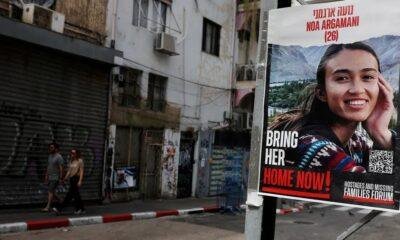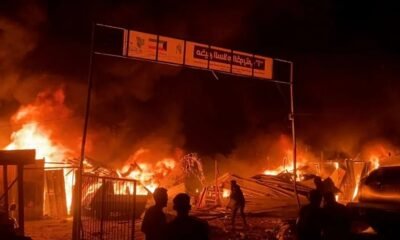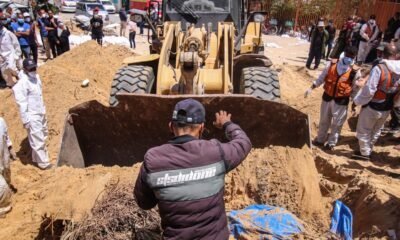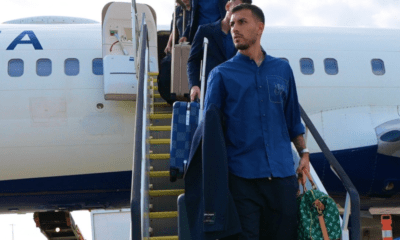INTERNACIONAL
More aid is supposed to be entering the Gaza Strip. Why isn’t it helping?

JERUSALEM (AP) — Under heavy U.S. pressure, Israel has promised to ramp up aid to Gaza dramatically, saying last week it would open another cargo crossing and surge more trucks than ever before into the besieged enclave.
But days later, there are few signs of those promises materializing and international officials say starvation is widespread in hard-hit northern Gaza.
FAMILIES OF AMERICAN HOSTAGES IN GAZA URGE BIDEN TO ACT AFTER 6 MONTHS OF CONFLICT: ‘DON’T HAVE TIME’ TO WAIT
Samantha Power, administrator of the U.S. Agency for International Development, said this week she accepted «credible» reports that famine is now occurring in the area and urged Israel to take further steps to expedite humanitarian aid shipments.
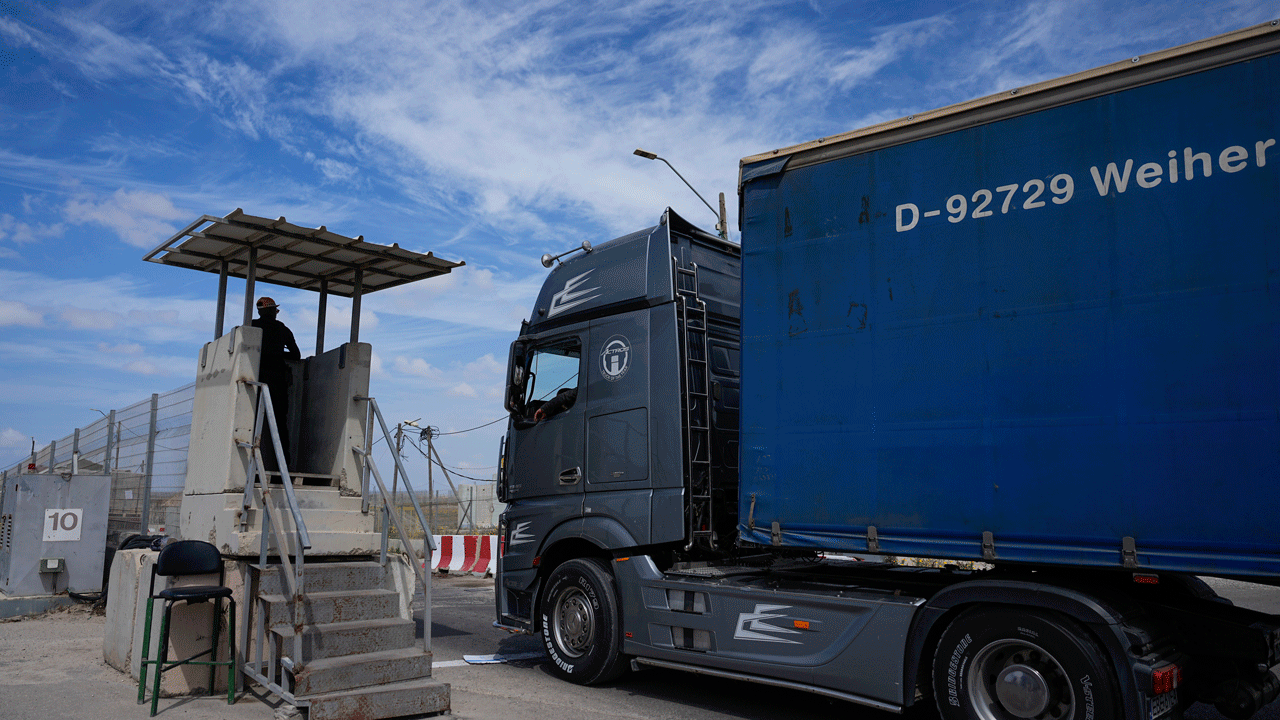
A truck carrying humanitarian aid for the Gaza Strip passes through the Kerem Shalom Crossing in southern Israel, Thursday, March 14, 2024. Under heavy U.S. pressure, Israel has promised to ramp up aid to Gaza dramatically, saying last week it would open another cargo crossing and surge more trucks than ever before into the besieged enclave. But days later, there are few signs of those promises materializing, and international officials say famine is fast approaching in hard-hit northern Gaza. (AP Photo/Ohad Zwigenberg)
Power’s remarks echoed those of U.S. President Joe Biden, who said on Wednesday that Israeli efforts to increase aid were «not enough.»
While Israel says it has dramatically increased the number of aid trucks entering the territory, U.N. workers report only a slight uptick — possibly because they count trucks differently.
Here’s what we know about the aid entering Gaza, and why discrepancies in reporting persist:
HOW MUCH AID IS ENTERING GAZA?
Israel says that since Sunday it has transported an average of 400 trucks a day into Gaza and that aid is now piling up on the Palestinian side of the Kerem Shalom crossing, one of two major crossings into the territory.
But Juliette Touma, communications director for the U.N. agency for Palestinian refugees, known as UNRWA, said that while aid workers have noticed a slight increase in the amount of aid entering Gaza, it’s nothing close to the surge Israel is claiming.
On Monday, UNRWA says 223 trucks of aid passed. On Tuesday, that number hit 246. On Wednesday, it was down to 141.
Meanwhile, only trickles of aid are reaching northern Gaza.
WHAT HAS ISRAEL PROMISED?
After Biden said last week that future American support for the war in Gaza depends on Israel doing more to protect civilians and aid workers, Israeli Prime Minister Benjamin Netanyahu promised a series of steps. Biden spoke out after an Israeli airstrike killed seven aid workers delivering food to the strip.
Netanyahu pledged to immediately re-open Israel’s Erez crossing into northern Gaza — a pedestrian crossing destroyed by Hamas militants when they stormed into southern Israel on Oct. 7. Netanyahu also said he would allow Israel’s port in Ashdod to process aid shipments and increase Jordanian aid packages through another land crossing.
But Israeli officials this week dropped the plan to open Erez. Instead, they say a new crossing will be built, though it is unclear when it will open. The Ashdod port, meanwhile, is not yet accepting aid shipments and Gaza aid groups report no significant increase in trucks received at their warehouses.
Before the latest Israel-Hamas war, some 500 trucks carrying food, fuel and other supplies entered Gaza daily. That was supplemented by fish and produce farmed within the territory.
Even that was barely enough in a crowded territory whose economy has been battered by a 17-year blockade imposed by Israel and Egypt. The blockade, meant to keep Hamas from arming, restricted the flow of goods in and out of Gaza and contributed to widespread poverty and unemployment.
Scott Anderson, the acting director of UNRWA in Gaza, said the low levels of aid since the war started have compounded an existing, pre-war nutrition deficit in the territory.
«You have to remember, this was not a nutrition-rich environment before the war. The resilience was not there,» said Anderson.
WHY IS THERE A DISCREPANCY BETWEEN THE UN AND ISRAEL’S NUMBERS?
Israel and the U.N. count trucks arriving in Gaza differently.
Israel counts every truck it inspects and allows to pass into Gaza, according to Shimon Freedman, a spokesperson for COGAT, the Israeli defense body in charge of Palestinian civilian affairs.
At the Kerem Shalom crossing, once the trucks pass into Gaza, the pallets of aid they are carrying are deposited in a 1-kilometer-long (a half-mile) zone for Palestinian drivers to pick up.
UNRWA only counts the trucks, driven by a Palestinian contractor, returning from that zone, Anderson said.
He also said that sometimes the trucks arriving from Israel are not fully loaded. Palestinian drivers on the Gaza side of the crossing load their trucks fully before passing through the gate — something that could further account for truck count differences.
WHAT IS SLOWING AID TRANSFER?
Getting from Israeli inspection, through the corridor and past the gate into Gaza takes time — and is made more arduous by the way Israel uses the Kerem Shalom crossing, Anderson said.
Since the war began, Israel has kept the crossing partially closed, Anderson said. Palestinian drivers must also wait for the incoming trucks to be unloaded — further narrowing the window of time allowed for pickup.
Aid inspected by Israel sometimes sits overnight, awaiting pickup. The U.N. says it stops all operations at 4:30 p.m. for safety purposes due to a breakdown in public order and airstrikes at night. UNRWA says they used to use local Palestinian police to escort aid convoys, but many refused to continue serving after airstrikes killed at least eight police officers in Rafah. Israel says armed Hamas militants have tried to siphon off aid.
COGAT denied allegations that they restrict the crossing’s hours or limit movement of trucks to pick up aid and blamed the U.N. for the backup, saying the agency does not have enough workers to move aid to warehouses for timely distribution.
WHAT HAPPENS MOVING FORWARD?
Israeli Defense Minister Yoav Gallant said Wednesday night that increasing aid efforts is a top priority.
«We plan to flood Gaza with aid and we are expecting to reach 500 trucks per day,» said Gallant. He did not specify a time frame for reaching that goal.
CLICK HERE TO GET THE FOX NEWS APP
But even if Israel meets its goal, slowdowns at the crossings and convoy safety concerns may continue to hamper distribution. The U.N. has called for a return to prewar procedures — with additional terminals open and a significant amount of commercial goods, in addition to humanitarian aid, able to pass through.
«Gaza has become very quickly dependent on relief handouts,» Touma said. «The market has been forced to shut. This is not sustainable.»
INTERNACIONAL
Mujeres suicidas: El arma oculta de un grupo terrorista
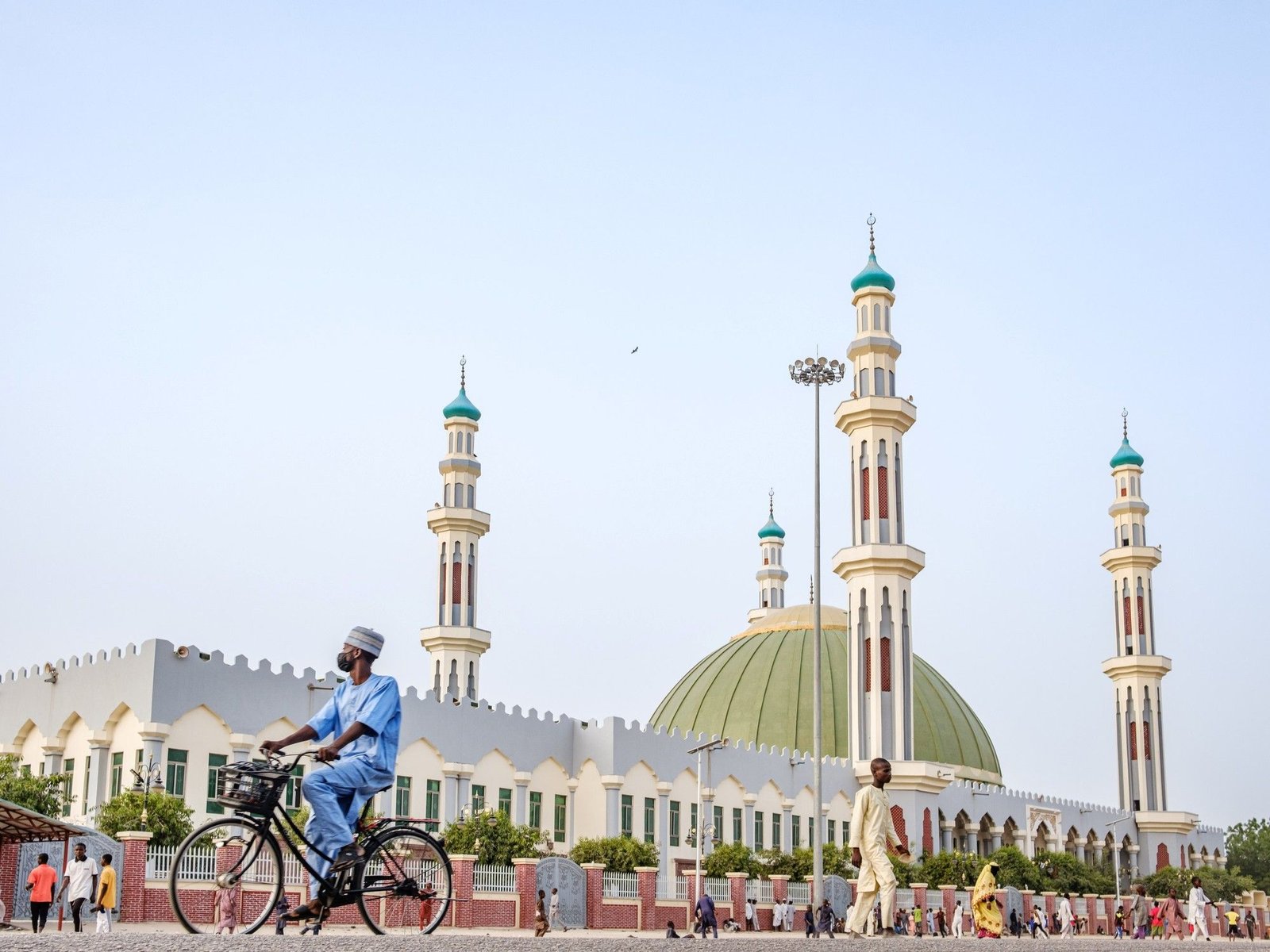
Una mujer sostenía a un bebé mientras detonaba una bomba durante el fin de semana en el norte de Nigeria, matándolos a ambos y al menos a media docena más, dijeron las autoridades locales, poniendo fin abruptamente a una rara pausa en la violencia que ha asolado la región durante más de una década.
A ella se unieron otras dos mujeres suicidas en el estado de Borno, Nigeria, que mataron al menos a 32 personas e hirieron a decenas más en una serie de atentados, según el vicepresidente Kashim Shettima.
Los ataques, dijeron los expertos, demostraron el complejo y mortal papel que pueden desempeñar las mujeres en insurgencias terroristas como Boko Haram.
Los atacantes atacaron tres lugares:
una celebración de boda, un área cercana a un hospital y un funeral para las víctimas del atentado anterior, dijo Barkindo Saidu, director general de la agencia de gestión de emergencias del estado de Borno.
Los ataques tuvieron lugar en la ciudad de Gwoza, una zona anteriormente controlada por Boko Haram durante 15 años.
Aunque ninguna organización se ha atribuido todavía la responsabilidad, los ataques son similares a atentados suicidas anteriores llevados a cabo por Boko Haram, un grupo islamista responsable de decenas de miles de muertes y el desplazamiento de más de 2 millones de personas en la región.
Boko Haram fue noticia en 2014 tras secuestrar a más de 200 colegialas.
Las mujeres son enviadas a la muerte porque “se mimetizan”.
Los grupos armados suelen utilizar a mujeres como atacantes suicidas porque las consideran menos valiosas para la organización y más ventajosas tácticamente, dijeron los expertos.
Ideales
 Víctimas heridas de un atentado suicida reciben tratamiento en un hospital de Maiduguri, Nigeria, el domingo. Foto Joshua Omiri/Associated Press
Víctimas heridas de un atentado suicida reciben tratamiento en un hospital de Maiduguri, Nigeria, el domingo. Foto Joshua Omiri/Associated Press«Las mujeres despiertan menos sospechas y son capaces de penetrar objetivos más profundamente», dijo Mia Bloom, profesora de comunicación en la Universidad Estatal de Georgia y experta en mujeres terroristas suicidas.
Bloom dijo que los grupos terroristas a menudo utilizan a mujeres cuando atacan a civiles o infraestructura cívica porque “se mezclan” y es menos probable que sean percibidas como amenazas.
Algunos grupos también ven a las mujeres como más fáciles de manipular, dijo Bloom, quien ha entrevistado a muchos sobrevivientes de Boko Haram.
Muchas de las mujeres que Boko Haram ha convertido en terroristas suicidas, afirmó, probablemente hayan sido agredidas sexualmente y estén traumatizadas.
 Una niña de una escuela de Chibok con su hijo, liberada hace algunos años por soldados nigerianos, es fotografiada en una casa del consejo del gobierno nigeriano local en Maiduguri, Nigeria. (Foto AP/Jossy Ola, Archivo)
Una niña de una escuela de Chibok con su hijo, liberada hace algunos años por soldados nigerianos, es fotografiada en una casa del consejo del gobierno nigeriano local en Maiduguri, Nigeria. (Foto AP/Jossy Ola, Archivo)Algunas mujeres pueden estar realmente radicalizadas, dijo, pero otras creen que «tienen más posibilidades de sobrevivir siendo bombarderas que casarse con un combatiente de Boko».
El grupo utilizó mujeres atacantes suicidas más de la mitad del tiempo.
Organizaciones terroristas como Boko Haram, Al Shabab y los talibanes han utilizado mujeres como terroristas suicidas, pero Boko Haram las ha utilizado con más frecuencia que otros grupos.
El grupo tiene un historial de secuestro y retención de niñas como rehenes antes de obligarlas a colocarse explosivos y enviarlas a misiones suicidas.
Boko Haram utilizó a niñas con tanta frecuencia en algunas zonas que el gobierno nigeriano lanzó una campaña antiterrorista con imágenes de niños pequeños con detonadores.
Una investigación realizada por el Centro de Lucha contra el Terrorismo en West Point encontró que el grupo utilizó mujeres como atacantes en más de la mitad de sus operaciones, incluidas misiones suicidas desde abril de 2011 hasta junio de 2017.
Muchas de las atacantes eran niñas.
Estilos terroristas
El ex líder de Boko Haram, Abubakar Shekau, asesinado en 2021, era conocido por enviar a niñas y mujeres a misiones suicidas, a menudo en contra de su voluntad.
Cameron Hudson, miembro principal del programa de África del Centro de Estudios Estratégicos e Internacionales, una organización de investigación con sede en Washington, calificó el uso de mujeres por parte de Boko Haram como una «característica» de su militancia que no se ve típicamente en los grupos de africanos occidentales de Malí y Níger, donde las mujeres no suelen ocupar puestos operativos.
Incluso si Boko Haram no se atribuye la responsabilidad del ataque, dijo Hudson, la participación de las mujeres muestra que el terrorismo en la región no está simplemente influyendo en los jóvenes descontentos.
«Comunidades enteras han sido cooptadas en esto», dijo.
«Estamos viendo una insurgencia comunitaria de base amplia».
La región está plagada de violencia.
Durante la última década, el Sahel, una vasta región semiárida que se extiende a lo largo de África occidental y central, ha dado origen a una serie de organizaciones islamistas empeñadas en la insurgencia.
Además de Boko Haram, la Provincia de África Occidental del grupo Estado Islámico también opera en la región.
El estado nigeriano de Borno, que limita con los países vecinos de Chad, Camerún y Níger, ha estado plagado durante mucho tiempo de violencia terrorista, primero a manos de Boko Haram y luego de grupos rivales y disidentes que luchan por el control del territorio.
Los combatientes de Boko Haram tomaron Gwoza en 2014 y Shekau, el líder del grupo en ese momento, declaró un califato antes de que el ejército nigeriano expulsara al grupo en 2015.
Los gobiernos civiles de toda la región, incluido el vecino Níger, han experimentado varios golpes militares en los últimos años.
Pero tanto los civiles como los regímenes militares han tenido dificultades para hacer frente a las amenazas que plantean las insurgencias islamistas.
La degradación ambiental, las privaciones económicas y los Estados extremadamente débiles han convergido para crear patrones de libre circulación a través de las fronteras nacionales, dijeron los expertos, incluida la de los militantes islamistas.
«Incluso si un país fuera capaz de lograr avances, es poco probable que afecte a la amplia franja de esta región», dijo Hudson.
«Lo que estamos viendo aquí es quizás el comienzo de un resurgimiento».
c.2024 The New York Times Company
-
POLITICA2 días ago
Cristina Kirchner reapareció y criticó al Gobierno: “El superávit fiscal es cada vez más trucho”
-
POLITICA23 horas ago
El PRO publicó un duro informe y cuestionó el rumbo del Gobierno: “Hay más interrogantes que certezas”
-
POLITICA2 días ago
Fuerte reclamo de la oposición dialoguista al Gobierno por la crisis económica tras la sanción de la Ley Bases
-
POLITICA2 días ago
Los mercados castigan a Milei, la ayuda de los «dinosaurios» y una anomalía del Senado
-
ECONOMIA2 días ago
Nuevo aumento de naftas y gasoil a partir del 1 de julio
-
POLITICA2 días ago
«No tenemos datos de Loan», admitió Patricia Bullrich desde la zona de rastrillajes para hallar al chico desaparecido en Corrientes

